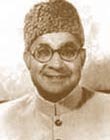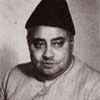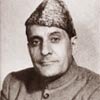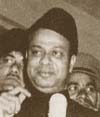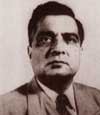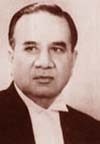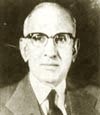|
|
 Muhammad Ali Jinnah takes over as first Governor General of newly independent state. |
|
|
|
|
|
|
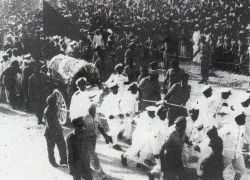 Jinnah dies on 11 Sep 1948 |
|
|
|
Captain Muhammad Sarwar embraces martyrdom and is awarded first Nishan-e-Haider |
|
|
|
|
|
|
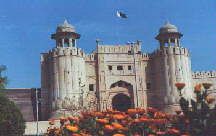 |
|
|
|
|
1947 - 1958 The Birth and Turmoil
Arrival of Muhammad Ali Jinnah at Karachi
"...My guiding principle will be justice and complete impartiality, and I am sure that with your support and cooperation, I can look forward to Pakistan becoming one of the greatest nations of the world." So said the Quaid-e-Azam (the Great Leader) soon after assuming the reins of the newly born Pakistan as its first governor general.
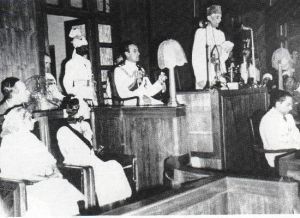
The new state faced many challenges. About 8 million Muslim refugees migrated from India to Pakistan, whose resettlement became the biggest challenge. There were some provincial politicians who often defied the authority of the central government, and frequent communal riots. Therefore emergency was declared on 27 August 1958 and provinces were asked to absorb more refugees.



The heavy work load and surmounting problems were
taking a heavy toll of Jinnah's already fragile health and before he could
amicably resolved the problems threatening the newly born state, Jinnah died on 11 September 1948, leaving the country in a
quagmire of political instability for years to come. Khawaja Nazim ud Din filled
the vacuum.
The Status of Independent States: At the time of independence, there were 562 states, of which 14 shared border with Pakistan. As per Indian Independence Act (section 7) the British hold on all such states ceased with effect from 14 august 1947 and were allowed to join either of the two newly independent countries. Of the 14 states, 11 decided to join Pakistan. However the State of Junagadh was forcibly occupied by India on 8 November 1947. The people of Baltistan, who were majority Muslims, did not want to be under the Hindu Dogra rule and announced war of independence and by 14 August 1948, the are was free from Dogra rule after fierce clashes with Indian and Dogra army.
Status of Muslim Majority Kashmir: Kashmir was a Muslim majority state though under a Sikh ruler who had bought the state from the British. However its fate changed with the announcement of Radcliff Award, which accorded areas , specially of Muslim majority Gurdaspur to India - the only land route available to India with Kashmir. This clearly showed the mal intentions hidden in the Award and soon after the independence, Pakistan and the Muslims of Kashmir raised concern over this. From here on the struggle for Kashmir starts, and a bitter chapter opened in the relations of India and Pakistan, which despite three wars has not been able to be closed. A separate page has been added on the subject to bring to forth many technical and emotional aspects related to the issue. Read More ...
Problems in NWFP: When the 3rd June declaration of independence was announced, Khan Abdul Ghaffar Khan and his elder brother Dr Khan Sahib (then Chief Minister NWFP) were not happy since they wanted NWFP to be declared independent and named as "Pakhtoonistan". Although Jinnah met Ghaffar Khan on 18 June 1947 to persuade him to accept the independence declaration according to which NWFP was to be merged into the newly formed state of Pakistan, but the latter refused. When Pakistan came into being, Muslim League was not in majority in NWFP. On 15 August 1947, Dr Khan and his cabinet refused to attend the Pakistan flag hoisting ceremony. Seeing the alienation of the Congress backed Dr Khan away from Pakistan, Jinnah dismissed his government on 22 August and Khan Abdul Qayyum Khan, a veteran politician of NWFP, to form the government.
The First Cabinet: The first cabinet of Pakistan, was sworn in on 15th August, which included: Liaquat Ali Khan (Prime Minister, also in charge of two ministries: Foreign Affairs & Commonwealth Relations, and Defense); I. I. Chundrigar (Commerce, Industries, and Works); Ghulam Mohammad (Finance); Abdur Rab Nishtar (Communications); Ghazanfar Ali Khan (Food, Agriculture, and Health); Jogendra Nath Mandal (Law and Labour); Fazlur Rahman (Interior, Information, and Education). Quaid-e-Azam also requested many competent British technocrats to stay: 3 out of the 4 governors were British - Sir Frederick Bourne (Governor, East Bengal), Sir Francis Mudie (Governor, West Punjab), and Sir George Cunningham (Governor, N.W.F.P.). Sir Ghulam Hussain Hidayatullah (Governor, Sindh) was the only native governor, while Balochistan did not have a governor as it was a Governor-General's province. All chiefs of the armed forces were British too: General Sir Frank Messervey (Royal Pakistan Army), Air Vice-Marshal Perry-Keane (Royal Pakistan Air Force), and Admiral Jefford (Royal Pakistan Navy). The financial advisor to the Governor-General, Sir Archibald Rowland, was also a British.



